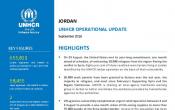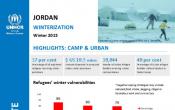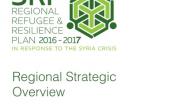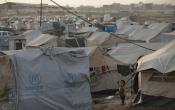Jordan
Operation: Jordan
Location
{"longitude":36,"latitude":31,"zoom_level":7}
Latest update of camps and office locations 13 Jan 2016. By clicking on the icons on the map, additional information is displayed.
Key Figures
| 2015 end-year results | |
| 100% | people of concern to UNHCR were registered |
| 26,000 | were assisted for birth registration |
| 24,000 | refugees were submitted for resettlement |
| 32,400 | households received cash assistance |
| 9,250 | shelters were maintained and upgraded |
| 33,000 | households received core relief items (CRI) |
| 6,000 | best interest assessments were conducted |
| 2016 planning figures | |
| 300,000 | Number of Syrian refugee and asylum-seeker families receiving cash grants |
| 20,000 | Number of Syrian refugees and asylum-seekers referred to secondary and tertiary medical care |
| 15,000 | Number of registered non-Syrian refugee children targeted to be enrolled in primary education |
| 15,000 | Number of households targeted to receive seasonal support |
Latest Updates and Related Links
People of Concern
2%
Increase in
2015
2015
| 2015 | 689,053 |
| 2014 | 672,930 |
| 2013 | 646,312 |

[["Refugees",664118],["Asylum-seekers",24935]]
Loading ...
Budgets and Expenditure for Jordan
< Back
2015
{"categories":[2012,2013,2014,2015,2016],"budget":[151.0265589,367.56731878,307.65103446,328.87751632,318.80353781],"expenditure":[85.75910185,234.03438702,206.68124577,208.74308994,null]}
{"categories":[2012,2013,2014,2015,2016],"p1":[151.0265589,367.56731878,307.65103446,328.87751632,318.80353781],"p2":[null,null,null,null,null],"p3":[null,null,null,null,null],"p4":[null,null,null,null,null]}
{"categories":[2012,2013,2014,2015,2016],"p1":[85.75910185,234.03438702,206.68124577,208.74308994,null],"p2":[null,null,null,null,null],"p3":[null,null,null,null,null],"p4":[null,null,null,null,null]}
Loading ...
CHOOSE A YEAR
- 2014
- 2015
- 2016
Working environment
- An increasingly managed border policy led to the reduction of Syrian new arrivals to Jordan through unofficial border crossing points, with an estimated 16,000 asylum-seekers stranded along the north-eastern border by year end.
- The situation for Syrian refugees became more challenging with the introduction of increased security protocols leading to the restrictions of movement and limited access to the informal labor market.
- The financial situation was unpredictable and resulted in cuts to food and cash assistance programmes in the beginning of the year. However, following the refugee flow to Europe, donations substantially increased and allowed assistance to be resumed in some areas.
- The number of refugees returning to the Syrian Arab Republic and moving to third countries increased.
- The conflict in Iraq resulted in an increase in the number of Iraqi refugees in Jordan.
Population trends
- Nearly 696,000 persons of concern were registered by end-2015.
- More than 90 per cent of persons of concern in Jordan are Syrians. Some 41,000 were registered in 2015. Only 18 per cent of refugees reside in refugee camps.
- The remaining 61,734 persons of concern are primarily Iraqis.
Achievements and impact
- Civil registration and status documentation were strengthened together with the Government of Jordan and partners.
- Cash assistance was provided through improved cash assistance mechanisms using ATM machines.
- Life-saving assistance was provided through the maintenance and upgrading of shelters and the distribution of CRI.
- UNHCR implemented the alternative care guidelines and procedures for unaccompanied and separated children with the Sharia and Juvenile Courts.
Unmet needs
- Due to lack of funding, community support projects to assist refugee-hosting communities were deprioritized.
- Some 66 per cent of refugees of nationality other than Syrian did not receive cash assistance due to a funding shortfall.
Working environment
The operational environment in Jordan continues to be considerably affected by the security situation in the neighbouring Syrian Arab Republic (Syria) and the influx of Syrians into the country, as well as by developments in Iraq and Gaza in 2014.Jordan provides asylum for a large number of refugees, including from Syria and Iraq. It has granted Syrian refugees access to services, such as health and education, in host communities. The Syrian refugee camps of Azraq and Zaatari were built on land provided by the authorities where they also ensure security.
Jordan continues to demonstrate hospitality, despite the substantial strain on national systems and infrastructure. In 2014, the Government published the National Resilience Plan 2014-2016, presenting “proposed priority responses to mitigate the impact of the Syrian crisis on Jordan and Jordanian host communities.” The authorities’ active engagement will likely influence the UNHCR-coordinated inter-agency refugee response.
Jordan is not a signatory to the 1951 Refugee Convention. Nonetheless, the Government refers to Syrians as refugees, and the protection space is generally favourable, although fragile owing to the country’s own socioeconomic challenges.
The 1998 memorandum of understanding (MoU) between UNHCR and the Government, partially amended in 2014, forms the basis for the Office’s activities in Jordan. In the absence of any international or national legal refugee instruments in force in the country, the MoU establishes the parameters for cooperation between UNHCR and the Government.
Needs and strategies
UNHCR’s foremost priority remains to ensure that Jordan’s largely favourable protection environment is maintained in 2015, despite new arrivals of Syrians potentially further straining already limited resources. This could have a negative impact on Jordanian public opinion of refugees and make preserving the country’s asylum space in the country challenging.The organization will ensure international protection standards are maintained for all those of concern and provide the authorities with technical support to boost the capacity of national institutions dealing with them. Timely registration will ensure refugees’ regular access to basic services, which is particularly important to prevent sexual and gender-based violence (SGBV) and for child protection. The Office will strengthen its outreach capacity and through the implementation of its urban policy, will aim to mitigate the impact of the presence of Syrian refugees on local communities.
The continuing influx of Syrians is likely to affect UNHCR’s activities to address the needs of Iraqi refugees in Jordan. RSD and resettlement will remain essential protection elements for the Iraqi refugee population. The response will closely monitor the status of those refugees at risk of becoming more destitute, due to increasingly limited access to services and infrastructure, and UNHCR will review its strategy for them with government counterparts.






